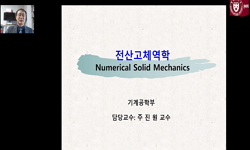In this study finite element model of the human lumbar spinal segments (L2-L5) was developed to parametrically examine the stiffness of a dynamic stabilization device and its influence on the mobility of adjacent intervertebral segments. Five models w...
http://chineseinput.net/에서 pinyin(병음)방식으로 중국어를 변환할 수 있습니다.
변환된 중국어를 복사하여 사용하시면 됩니다.
- 中文 을 입력하시려면 zhongwen을 입력하시고 space를누르시면됩니다.
- 北京 을 입력하시려면 beijing을 입력하시고 space를 누르시면 됩니다.


Comparing an Instrumented Posterior Fixation System with Rigid and Semi-Flexible Rods using Finite Element Analysis
한글로보기https://www.riss.kr/link?id=A107607111
- 저자
- 발행기관
- 학술지명
- 권호사항
-
발행연도
2015
-
작성언어
-
- 주제어
-
등재정보
SCIE,KCI등재
-
자료형태
학술저널
-
수록면
163-170(8쪽)
- 제공처
-
0
상세조회 -
0
다운로드
부가정보
다국어 초록 (Multilingual Abstract)
In this study finite element model of the human lumbar spinal segments (L2-L5) was developed to parametrically examine the stiffness of a dynamic stabilization device and its influence on the mobility of adjacent intervertebral segments. Five models were analyzed and compared: (1) a lumbar spine with intact discs, a reference; (2) a fused spine with a fixation device following interbody fusion and total laminectomy; (3) a spine stabilized with a dynamic stabilization device following total laminectomy; and (4) an additional vertically parallel paired dynamic posterior fixator and paired rigid fixator implemented at levels L3-L5. The disc pressure on the adjacent segments in the fused spine was greater than that of the intact spine, but the disc pressure of the dynamically stabilized spine was similar to that of the intact spine. The use of dynamic stabilization devices restored functionality more closely to that of the intact spine compared to the fused spine. The stiffness values utilized in the device were determined to be important design parameters for manufacturing dynamic stabilization devices.
동일학술지(권/호) 다른 논문
-
Classification of Defects in a Thermal Barrier Coating Layer using the Fuzzy C-means Algorithm
- 한국정밀공학회
- 김평호
- 2015
- SCIE,KCI등재
-
- Korean Society for Precision Engineering
- Hwang, Young-Kug
- 2015
- SCIE,KCI등재
-
Method For Estimating Temperature of 4WD Coupling Device Wet Clutches in Severe Operating Condition
- Korean Society for Precision Engineering
- Seo, Howon
- 2015
- SCIE,KCI등재
-
Design of Rotor Profile of Internal Gear Pump for Improving Fuel Efficiency
- Korean Society for Precision Engineering
- Bae, Jun-Ho
- 2015
- SCIE,KCI등재




 ScienceON
ScienceON






